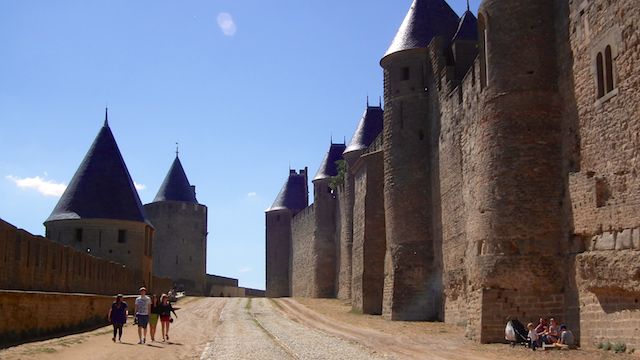CARCASSONNE
Carcassonne: the River Aude runs through it 60 miles southeast of Toulouse. The Canal du Midi also passes through Carcassonne, on the way north to Toulouse, and south toward the Camargue.
The medieval city of Carcassonne was built on the hilltop ruins of a 1st-century Roman Gaul fortress. The well-preserved and restored castle encloses a maze of medieval streets with over 3 km of double walls. There are more than 50 towers. This is one of the most visited old fortified cities in France. One can see why; it’s very intact and very impressive. It fits the bill for medieval castle-fortress junkies.
Fortunately, we were there early in the day, at the heel of the tourist season in September and it was not terribly crowded.
Some of us love to ramble around an old castle and try to get a feel for what it was like living here in the days of old.


Thanks to Danny, our Classicist friend, I have been personally driven in a small way to try to make some sense of what was happening in these places, to connect some dots historically, as it were.
One must do a lot of reading and really go out of one’s way to get a grasp on any of this. A good source for me is Barbara Tuchman’s, A Distant Mirror. This award-winning book is an extremely detailed history of the 14th Century, possibly the darkest period of human history: the plague, the destruction of the Knights Templar, the 100 Years War—the great schism of the Catholic Church when seeds of future Protestantism were sewn.
I have already given some 'armchair/journalistic' historical references in the blog as we have moved along on our trip from one place to another. While some readers may have an interest in these things, I recognize that many do not and will choose to skim over the dry stuff.
But don’t give up on me yet because there will be lots more interesting stories to come, including plenty of photos that will not be seen in any brochures or websites.
Anyway, our few hours in Carcassonne brings me back to early history.
Rome was sacked in 410 by the Visigoths (a Germanic nomadic people) and collaborators. They moved on to Portugal and Spain where they settled.
They expanded and continued with the development of Western civilization. The Visigoths spread eastward again and established themselves in Toulouse.
In 700 the Visigoths were beaten down by the Muslim invasion. The Saracens/Moors took Carcassonne but not the fortress. It was impregnable.
In 1067 Carcassonne was held by the Viscount of Albi and Nimes, and it was blessed by Pope Urban ll (of Rome) in 1067.
But trouble was brewing.
Between the 11th and 13th centuries, Carcassonne became a stronghold of the Cathars. Remember the Albigensians from my chapter on Albi? Their dualistic view of God was heretical to the Roman Catholics.
They were pariahs to the status quo Christians and had to be dealt with. And they were!
One of the worst acts of genocide perpetrated by the men of God was the massacre of thousands of Cathars—men, women and children.
The 4th Crusade (1202-1204) was a disaster for France and England. Heroic knight and nobleman, Simon de Montfort, was more or less out of a job and he was contracted by the Church to annihilate the heretics once and for all.
The French Inquisition was established in 1229 by the Church in Toulouse to eliminate any surviving members of Catharism.
By 1247 King Louis lX took control of Carcassonne.
The English and the French duked it out in the Hundred Years War from 1337 to about 1453. England had control on and off over large areas of French territories during this time but try as they might, their sieges against Carcassonne were unsuccessful. Even the Black Prince, Edward lll, in the Great Raid of 1355 could not take the fortress. Instead, he burnt everything and everyone around it to the ground.
The French Popes of Avignon took charge of Carcassonne and the Catholic Church ran the show there through the remainder of the 14th century.
Today, Carcassonne's economy is primarily tourism and wine production. We have partaken of both and our experiences have been rewarding.
For more travel photography with local information visit my website.












No comments:
Post a Comment